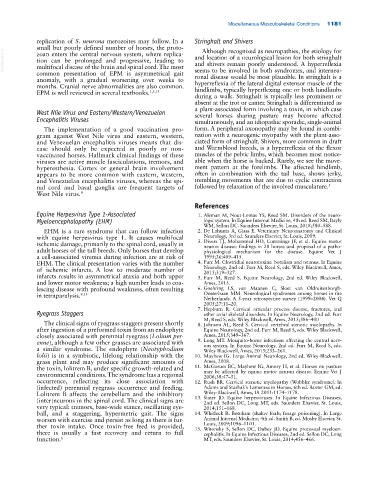Page 1215 - Adams and Stashak's Lameness in Horses, 7th Edition
P. 1215
Miscellaneous Musculoskeletal Conditions 1181
replication of S. neurona merozoites may follow. In a Stringhalt and Shivers
small but poorly defined number of horses, the proto Although recognized as neuropathies, the etiology for
VetBooks.ir tion can be prolonged and progressive, leading to and location of a neurological lesion for both stringhalt
zoan enters the central nervous system, where replica
and shivers remain poorly understood. A hyperreflexia
multifocal disease of the brain and spinal cord. The most
common presentation of EPM is asymmetrical gait seems to be involved in both syndromes, and interneu
anomaly, with a gradual worsening over weeks to ronal disease would be most plausible. In stringhalt is a
months. Cranial nerve abnormalities are also common. hyperreflexia of the lateral digital extensor muscle of the
EPM is well reviewed in several textbooks. 1,5,15 hindlimbs, typically hyperflexing one or both hindlimbs
during a walk. Stringhalt is typically less prominent or
absent at the trot or canter. Stringhalt is differentiated as
a plant‐associated form involving a toxin, in which case
West Nile Virus and Eastern/Western/Venezuelan several horses sharing pasture may become affected
Encephalitis Viruses simultaneously, and an idiopathic sporadic, single‐animal
The implementation of a good vaccination pro form. A peripheral axonopathy may be found in combi
gram against West Nile virus and eastern, western, nation with a neurogenic myopathy with the plant‐asso
and Venezuelan encephalitis viruses means that dis ciated form of stringhalt. Shivers, more common in draft
ease should only be expected in poorly or non‐ and Warmblood breeds, is a hyperreflexia of the flexor
vaccinated horses. Hallmark clinical findings of these muscles of the pelvic limbs, which becomes most notice
viruses are active muscle fasciculations, tremors, and able when the horse is backed. Rarely, we see the move
hyperesthesia. Cortex or general brain involvement ment pattern at the forelimbs. The affected hindlimb,
appears to be more common with eastern, western, often in combination with the tail base, shows jerky,
and Venezuelan encephalitis viruses, whereas the spi trembling movements that are due to cyclic contraction
nal cord and basal ganglia are frequent targets of followed by relaxation of the involved musculature. 5
West Nile virus. 9
References
Equine Herpesvirus Type 1‐Associated 1. Aleman M, Nout‐Lomas YS, Reed SM. Disorders of the neuro
Myeloencephalopathy (EHM) logic system. In Equine Internal Medicine, 4th ed. Reed SM, Bayly
WM, Sellon DC. Saunders Elsevier, St. Louis, 2018;580–588.
EHM is a rare syndrome that can follow infection 2. De Lahunta A, Glass E. Veterinary Neuroanatomy and Clinical
with equine herpesvirus type 1. It causes multifocal Neurology, 3rd ed. Saunders Elsevier, St. Louis, 2009.
ischemic damage, primarily to the spinal cord, usually in 3. Divers TJ, Mohammed HO, Cummings JF, et al. Equine motor
neuron disease: findings in 28 horses and proposal of a patho
adult horses of the tall breeds. Only horses that develop physiological mechanism for the disease. Equine Vet J
a cell‐associated viremia during infection are at risk of 1995;26:409–415.
EHM. The clinical presentation varies with the number 4. Furr M. Clostridial neurotoxins: botulism and tetanus. In Equine
of ischemic infarcts. A low to moderate number of Neurology, 2nd ed. Furr M, Reed S, eds. Wiley Blackwell, Ames,
2015;319–327.
infarcts results in asymmetrical ataxia and both upper 5. Furr M, Reed S. Equine Neurology, 2nd ed. Wiley Blackwell,
and lower motor weakness; a high number leads to coa Ames, 2015.
lescing disease with profound weakness, often resulting 6. Goehring LS, van Maanen C, Sloet van Oldruitenborgh‐
in tetraparalysis. 9,13 Oosterbaan MM. Neurological syndromes among horses in the
Netherlands. A 5‐year retrospective survey (1999–2004). Vet Q
2005;27:11–20.
7. Hepburn R. Cervical articular process disease, fractures, and
Ryegrass Staggers other axial skeletal disorders. In Equine Neurology, 2nd ed. Furr
M, Reed S, eds. Wiley Blackwell, Ames, 2015;386–400
The clinical signs of ryegrass staggers present shortly 8. Johnson AL, Reed S. Cervical vertebral stenotic myelopathy. In
after ingestion of a preformed toxin from an endophyte Equine Neurology, 2nd ed. Furr M, Reed S, eds. Wiley Blackwell,
closely associated with perennial ryegrass (Lolium per- Ames, 2015;349–367.
enne), although a few other grasses are associated with 9. Long MT. Mosquito‐borne infections affecting the central nerv
a similar syndrome. The endophyte (Neotyphodium ous system. In Equine Neurology, 2nd ed. Furr M, Reed S, eds.
Wiley Blackwell, Ames, 2015;233–261.
lolii) is in a symbiotic, lifelong relationship with the 10. Mayhew IG. Large Animal Neurology, 2nd ed. Wiley‐Blackwell,
grass plant and may produce significant amounts of Ames, 2008.
the toxin, lolitrem B, under specific growth‐related and 11. McGorum BC, Mayhew IG, Amory H, et al. Horses on pasture
environmental conditions. The syndrome has a regional may be affected by equine motor neuron disease. Equine Vet J
2006;38:47–51.
occurrence, reflecting its close association with 12. Rush BR. Cervical stenotic myelopathy (Wobbler syndrome). In
(infected) perennial ryegrass occurrence and feeding. Adams and Stashak’s Lameness in Horses, 6th ed. Baxter GM, ed.
Lolitrem B affects the cerebellum and the inhibitory Wiley‐Blackwell, Ames, IA 2011:1174–1178.
(inter)neurons in the spinal cord. The clinical signs are 13. Slater JD. Equine herpesviruses. In Equine Infectious Diseases,
2nd ed. Sellon DC, Long MT, eds. Saunders Elsevier, St. Louis,
very typical: tremors, base‐wide stance, oscillating eye 2014;151–168.
ball, and a staggering, hypermetric gait. The signs 14. Whitlock R. Botulism (shaker foals; forage poisoning). In Large
worsen with exercise and persist as long as there is fur Animal Internal Medicine, 4th ed. Smith B, ed. Mosby Elsevier, St.
Louis, 2009;1096–1101.
ther toxin intake. Once toxin‐free feed is provided, 15. Witonsky S, Sellon DC, Dubey JD. Equine protozoal myeloen
there is usually a fast recovery and return to full cephalitis. In Equine Infectious Diseases, 2nd ed. Sellon DC, Long
function. 6 MT, eds. Saunders Elsevier, St. Louis, 2014;456–466.

